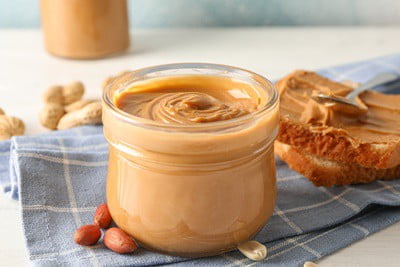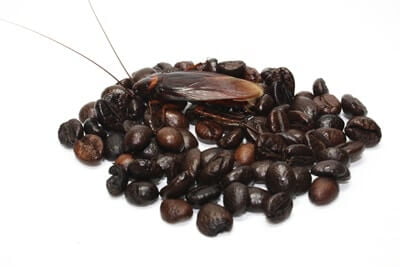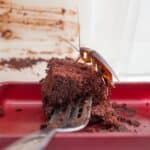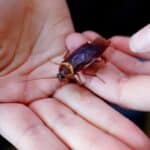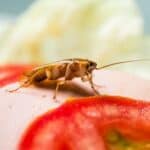Because peanut butter is commercially processed, it’ll be exposed to the dangers of processing plants. It may come into contact with pests of every kind, including cockroaches. It’s impossible to completely eradicate these pests from a factory. So, peanut butter is processed with trace pieces of cockroaches in it.
Peanut butter contains tiny fragments of cockroaches. Of course, peanut butter isn’t made exclusively from insect parts, but the processing stage allows for small pieces of insects to fall in. Under current FDA rules, insect parts are considered too insignificant to lead to health issues in humans.
This may be disturbing to discover, but it’s okay for humans to eat peanut butter, even if it has tiny cockroach fragments mixed in. The same is true of organic peanut butter, almond butter, and almost every kind of butter. While not every jar will contain bits of cockroaches, it’s impossible to know which ones do and don’t.
Does Peanut Butter Have Roaches in It?
There’s a small chance that your peanut butter has cockroach bits in it. Indeed, the FDA allows an average of around 30 or more insect fragments (per 100 grams) to be left in peanut butter before it’s sold.
You may also find other unintended add-ins, such as rodent hair and grit. The FDA allows 1 or more rodent hairs per 100 grams. This is matched to 25 milligrams of grit or water-insoluble inorganic residue per 100 grams.
Your particular jar of peanut butter may not have any traces of roaches, rodent hair, or grit in it whatsoever. The above values are the maximum values that the FDA allows to legally be inside peanut butter being sold across the country.
Peanut butter with these specks of insects and other things is not necessarily bad for your health. The FDA would not allow it to be sold otherwise.
Though off-putting to discover, know that you can still eat peanut butter safely. There should be little worry about contaminants from other creatures or critters that might wander around a peanut butter factory or processing plant.
If this thought disgusts you, it’s worth looking for alternatives. There are no peanut butter brands that are completely safe, but you can try homemade and organic varieties.
What Does Every Jar of Peanut Butter Contain?
The recipes may differ slightly depending on the brand, but the spread itself should contain:
- Peanuts
- Salt
- Oils
- Sugars
According to the Journal of Food Science and Technology, peanut butter contains a wealth of essential nutrients, vitamins, and minerals. This includes:
- Protein
- Fibers
- Polyphenols
- Antioxidants
- Magnesium
- Phosphorus
- Zinc
- Niacin
- Vitamin B-6
- Vitamin E
The daily recommended intake of each nutrient will vary. This depends on a variety of factors, including:
- Age
- Weight
- Height
- Sex
- Preexisting health conditions
The United States Department of Agriculture has recorded peanut butter as a great source of many nutrients. The following values are based on smooth peanut butter with added salt content:
| Nutrients | Peanut Butter Value |
|---|---|
| Protein | 22.5 grams |
| Fat | 51.1 grams |
| Fiber | 4.8 grams |
| Sugars | 10.5 grams |
| Calcium | 49 milligrams |
| Iron | 1.73 milligrams |
| Magnesium | 169 milligrams |
| Phosphorus | 339 milligrams |
| Potassium | 564 milligrams |
| Sodium | 429 milligrams |
| Zinc | 2.54 milligrams |
| Niacin | 13.3 milligrams |
| Vitamin B-6 | 0.44 milligrams |
| Vitamin E | 9.11 milligrams |
What Does the FDA Allow Peanut Butter to Contain?
The U.S. Food and Drug Administration states that 90 percent or more of peanut butter should solely be made up of peanuts to qualify. The remaining 10 percent will comprise various additives, such as salt, sugar, and both natural and added oils.
These are used to keep the natural oils in peanut butter from floating to the top and ruining the consistency. These added oils will also help extend the shelf life of peanut butter.
Various types of oil may be added to your peanut butter. The most common include:
- Palm fruit oil
- Hydrogenated vegetable oils
- Hydrogenated rapeseed/cottonseed oil
- Partially hydrogenated oils
Of course, just because these oils are added to enhance the appearance of peanut butter, this does not automatically make them healthy to consume in large quantities.
Palm fruit oil and any hydrogenated oils are high in saturated fats. This can increase your risk of cardiovascular issues in the future, as well as clog your arteries.
You might gravitate towards more organic peanut butter as a result. These spreads tend to be made up of fewer ingredients and utilize fewer oils in their recipes.
It’s still good to note that no artificial flavorings, chemical preservatives, colorings, additives, or sweeteners can be added to peanut butter.
This does not mean you will not find any unpleasant surprises in your peanut butter, however. If you’re wondering, “Are there roaches in peanut butter?” then the answer is yes, albeit in very limited quantities.
Does Organic Peanut Butter Have Bugs in It?
Processed peanut butter has a chance of containing bug pieces in it. You might then wonder if organic peanut butter is the same.
Organic peanut butter differs from other spreads due to the way it is processed. Unlike other types that add sugar and excess oils to preserve the spread for longer periods of time, organic peanut butter is only comprised of peanuts and salt. The way the peanuts themselves are grown and processed may also contribute to their organic status.
Plenty of brands promote clean eating, but they’re not being entirely truthful in how they handle their foods. Indeed, clean eating as a concept is vague, as “processed” foods can mean anything. This ranges from being washed and refrigerated before it is put on sale to putting preservatives in the food to make it last longer.
Organic foods are no more protected than other kinds of foods. Unfortunately, this means your organic peanut butter may have insect fragments in it, too.
The American Council on Science and Health also states that organic foods are not healthier, safer, or more nutritious than other foodstuffs. Animals and insects will still linger around organic food.
This means their feces, hair, or even parts of themselves may fall into some of it on occasion. You cannot guarantee that any food you eat is completely free of these insect fragments or other unpleasant bits, sadly.
Does Almond Butter Have Bugs in It?
Almond butter isn’t guaranteed to not have bugs in it, either. This butter may still have trace amounts of insect parts inside, according to the FDA’s regulations.
It can be disheartening to know that no type of delicious butter or spread is immune to having insect fragments in it. However, know that these allowed bits will not make you sick, nor will they ruin the consistency or flavor.
Almond butter is an alternative spread for those allergic to peanuts. Peanuts are technically classified as legumes, while almonds are classified as tree nuts. Only around 30 percent of all people with peanut allergies will also have a tree nut allergy.
Peanut butter does offer plenty of nutrients essential to your diet, despite the potential cockroach fragment mixed in. Let’s take a closer look at the nutritional value of 100 grams of smooth almond butter, in contrast.
| Nutrient | Almond Butter Value |
|---|---|
| Protein | 21 grams |
| Fat | 55.5 grams |
| Fiber | 10.3 grams |
| Sugars | 6.27 grams |
| Calcium | 347 milligrams |
| Iron | 3.49 milligrams |
| Magnesium | 279 milligrams |
| Phosphorus | 508 milligrams |
| Potassium | 748 milligrams |
| Sodium | 227 milligrams |
| Zinc | 3.29 milligrams |
| Niacin | 3.16 milligrams |
| Vitamin B-6 | 0.1 milligrams |
| Vitamin E | 24.2 milligrams |
As you can see from the values above, almond butter is lower in protein and sugar content. It’s then higher in fats, fibers, and certain vitamin and mineral content.
According to Nutrients, almonds can change the gut’s microbiota no matter what form they take (i.e., roasted, chopped, or in almond butter). This means that eating almonds can aid in digestive health.
